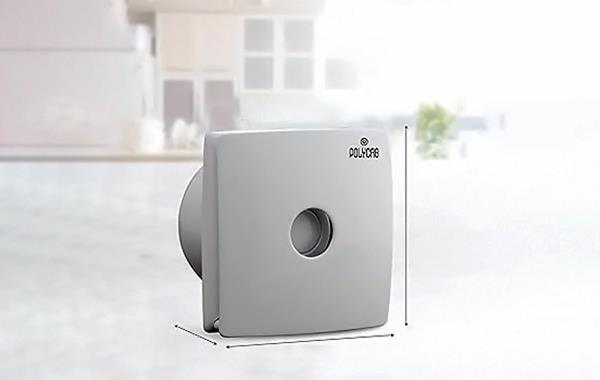How To Measure & Install Exhaust Fans For Your Bathroom & Kitchen

- April 01, 2025
- No comments yet
How To Measure & Install Exhaust Fans For Your Bathroom & Kitchen
Exhaust fans are the most understated element of a healthy and well-ventilated home or commercial space. They are the fundamental pillars that ensure the air circulates properly, maintaining a breathable and fresh-smelling environment. Without proper ventilation, your bathroom and kitchen space can quickly release unwanted odours, ruining the living experience. If you're planning a home upgrade or a simple DIY fix, understanding how to install exhaust fans is crucial. This guide will walk you through everything you need to know—from selecting the correct exhaust fan size to exhaust fan installation tools and overcoming common installation problems.
The Importance of Exhaust Fans in Bathrooms & Kitchens
The bathroom and kitchen spaces in a home are highly prone to moisture and bad smells. An exhaust fan helps regulate humidity, reduce condensation, and improve air quality by expelling stale or polluted air from these areas. However, before installing a bathroom exhaust fan, it is necessary to have accurate bathroom exhaust fan sizing numbers. An oversized exhaust fan for the bathroom or kitchen will consume unnecessary power and result in more noise. Not having an exhaust fan in your bathroom or kitchen can damage your home's interiors and pose a risk to your health.
What is an Exhaust Fan and Why is It Essential for Your Home?
An exhaust fan is a ventilation device attached to a fencing system that removes smelly air, moisture, smoke, and odours from an enclosed area. Placing an exhaust fan in the kitchen helps to eliminate smoke and cooking fumes while you cook delicious meals for your family. Exhaust fans for the bathroom help to remove excess humidity and prevent the growth of mold, thus radiating a fresh smell. A high-performance exhaust fan is essential for maintaining a clean, healthy kitchen and bathroom environment.
How to Measure Your Bathroom or Kitchen for an Exhaust Fan
Before purchasing an exhaust fan, determine the appropriate size of the kitchen or bathroom space where it will be installed. The size of an exhaust fan is calculated based on its sweep and air displacement capacity. The sweep size refers to the diameter of the fan blades, while the air displacement capacity of an exhaust fan is measured in Cubic Feet per Minute (CFM). The larger the kitchen or bathroom space, the higher the CFM rating of the exhaust fan will be required to ventilate the area.
Learning how to install exhaust fans begins with their size. Here are the steps for measuring the size of the exhaust fan installation.
Bathroom Exhaust Fan Sizing
- Calculate the bathroom volume by multiplying its length, width, and height, measured in feet.
- Calculate the required cubic feet per minute (CFM) from the square footage. For every square foot, an exhaust fan of 1 CFM is needed.
- The typical size of bathrooms in Indian homes is up to 50 square feet. So, you will need a bathroom exhaust fan with a minimum of 50 CFM.
- If the bathroom space is large, the appropriate bathroom exhaust fan size can increase by up to 100 CFM or more.
Choosing the right Kitchen Exhaust Fan Size
- Kitchen spaces require stronger airflow to maintain proper ventilation and make the space breathable while cooking.
- Therefore, the required CFM for a kitchen exhaust fan needs to be higher to effectively remove cooking smoke, spice odours, and steam.
- For kitchens with a size of 100 sq. feet, an exhaust fan with 200 CFM is ideal. For commercial kitchens with larger sizes, the kitchen exhaust fan size should be more than 500 CFM.
Tools and Materials You Need for Installing Exhaust Fans
Once the right measurements for exhaust fan size are obtained, gather these exhaust fan installation materials to begin the fitting process.
Exhaust fan installation tools:
- Wire strippers
- Measuring tape
- Ladder
- Safety Googles and Gloves
- Screwdriver
- Drilling machine
Exhaust Fan Installation Materials:
- Ductwork (if external venting is required)
- Ventcap
- Exhaust fan (choose from a wide range of Polycab exhaust fans for durable performance)
- Screws and mounting brackets
- Electrical wires and connectors
How to Install Exhaust Fans in Your Bathrooms
Installing a bathroom exhaust fan may seem like a daunting task. But following the right approach elaborated in this guide can be a rewarding DIY project.
- Switch off the Power supply: Before you begin with the bathroom fan installation guide, turn off the power at the switch.
- Mark the location: Based on the bathroom exhaust fan sizing, mark the cutout points where the fan will be installed. Use a drilling machine to locate the ceiling joists.
- Create the Opening: Cut a hole in the ceiling space that is the appropriate size for the exhaust fan to create the opening for mounting.
- Set up the fan Fencing: A fan housing holds the bathroom exhaust fan between joists using mounting brackets.
- Connect the ductwork: Attach the ducting to your bathroom exhaust fan and route it to the exterior vent.
- Connect the wires:Connect the bathroom exhaust fan wiring to the power supply using a wire stripper. Follow the steps stated in the manufacturer's instructions.
- Mount the Fan Cover: Secure the grill or exhaust fan cover to the mounting fence to complete installing a bathroom exhaust fan.
- Conduct bathroom exhaust fan testing: Ensure that the screws are tight, and the exhaust fan is well mounted. Restore the power and check the exhaust fan for proper operation.
Installing Exhaust Fans in Your Kitchen
Installing kitchen exhaust fans is similar to installing a bathroom exhaust fan.
- Determine the Ideal Location: Ideally, the exhaust fan must be above the gas stove, but at a height. Depending on your kitchen space and the dimensions of the exhaust fan, choose a wall-mounted placement.
- Create External Venting: Vent the kitchen exhaust fan outside the kitchen space.
- Create an Opening for the Kitchen Exhaust fan: Use a drilling machine to mark the location and create an opening in the wall.
- Set up the Ducting: A semi-rigid duct helps to minimize the oil or grease buildup in the exhaust fan.
- Join the wiring: Connect the exhaust fan wires with the wires in the power supply, following safe electrical practices.
- Seal and Test: Use a weatherproof sealant to prevent air leaks and install the cover. Look for any loose screws or fitting. If everything seems right, switch on the power and test the exhaust fan.
Common Installation Mistakes to Avoid
While following the steps in this DIY guide, there can be some common exhaust fan installation problems. A few of them are listed below.
- Undersized Fan: If the exhaust fan is the wrong size, it leads to poor airflow, increased noise, and ineffective ventilation.
- Improper Ducting: Long or bent ducts reduce the efficiency of bathroom exhaust fans.
- No External Venting: Lack of external venting causes moisture accumulation within the blades of the exhaust fan.
- Loose Wiring: Any screws left loose, or live wire left unattended can lead to malfunctioning of the exhaust fan and pose a safety hazard for people.
- Ignoring Local Codes: Failing to follow local codes while learning how to install exhaust fans can lead to compliance issues.
- Incorrect location: Placing the exhaust fan in the wrong location in the bathroom or kitchen is the most common DIY exhaust fan installation issue. This mistake reduces the effectiveness of the bathroom or kitchen exhaust fan.
Why Choose Polycab Exhaust Fans for Your Bathroom & Kitchen
Polycab is a renowned name in the nation for manufacturing world-class wires and cables. Through the years, it has gained a trusted name in the electrical and home appliances industry. Here are a few reasons why you must choose Polycab Exhaust fans for your bathroom and kitchen spaces.
- High Air Delivery: Polycab kitchen and bathroom exhaust fans are designed for efficient air circulation for optimum ventilation. With speeds of up to 2000 RPM, they are effective in removing bad, smelly air, making the space optimized for breathing.
- Low Noise Operation: Polycab kitchen and bathroom exhaust fans have quiet performance for an uninterrupted and peaceful living experience.
- Easy Maintenance: Polycab bathroom exhaust fans or kitchen exhaust fans require little to minimal maintenance. Designed for convenience, they are easy to clean, ensuring long-term performance with less maintenance efforts.
- Aesthetic Designs: The wide range of Polycab’s exhaust fans wear sleek, modern styles that complement your kitchen or bathroom interiors.
- Durability & Reliability: Polycab exhaust fans have features like anti-rust coating and heavy-duty motors built with high-grade materials and superior craftsmanship, thus ensuring their durability and reliability in the toughest environments.
- Super ROI: A good ROI on exhaust fans is crucial because it ensures better lower energy bills and reduced replacement costs over the years. Polycab Exhaust Fans offer exceptional value with their high performance, energy efficiency, and long-lasting durability. Their low maintenance needs and sturdy build ensure cost savings over time, making them a smart investment for homes and businesses alike.
This was all about how to install exhaust fans in the kitchen or bathroom. Remember, if you consistently face DIY exhaust fan installation issues, it's always better to ask for professional help to avoid complex wiring or duct-vent tasks. Take proper measurements, invest in quality tools, and choose a renowned brand of kitchen and bathroom exhaust fan to keep your home air fresh and healthy.
RECENT POSTS
- Where & How to Install LED Strip Lights for That Sleek, Modern Glow
- How to Use LED Strip Lights on Ceilings for a Modern Aesthetic
- 7 Bright Lighting Ideas to Refresh Your Living Space with Polycab LEDs
- 5 Things to Look for Before Selecting an Exhaust Fan for Your Home
- 5 Key Factors to Consider Before Buying Modular Switches and Sockets
 Fans
Fans
 Wires
Wires
 Lighting
Lighting
 Switches and Accessories
Switches and Accessories
 Water Heaters
Water Heaters
 Switchgear
Switchgear
 Polycab Home Advisors
Polycab Home Advisors
 Cables by Application
Cables by Application Cables by Standards
Cables by Standards Cables by Type
Cables by Type Renewables
Renewables Corporate
Corporate News and Media
News and Media Life at Polycab
Life at Polycab Contact Us
Contact Us Financial & Corporate Information
Financial & Corporate Information Annual Reports
Annual Reports Shareholder’s Information
Shareholder’s Information Credit Ratings
Credit Ratings Latest Updates
Latest Updates Notices
Notices Corporate Governance
Corporate Governance Corporate Action History
Corporate Action History Investors Contacts
Investors Contacts Disclosures under Regulation 46
Disclosures under Regulation 46


